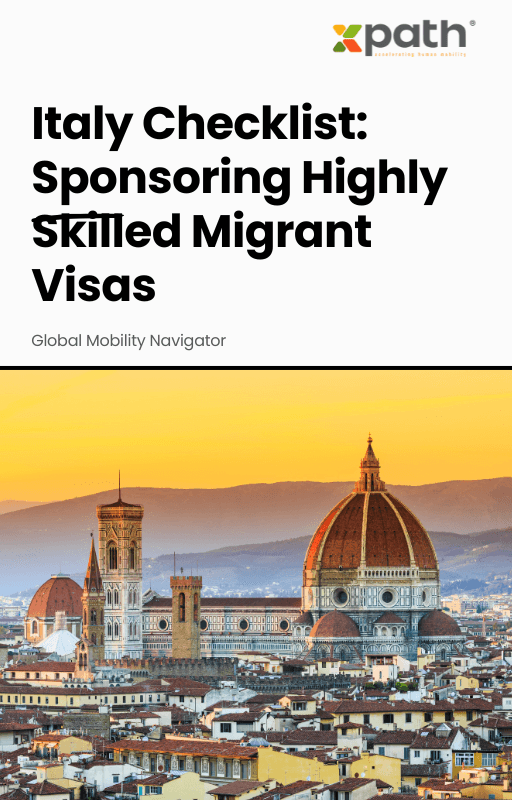Italy Checklist: Sponsoring Highly Skilled Migrant Visas
Grab a copy of a guide to international employee relocation
View E-bookThe EU Blue Card has become one of the most sought-after residence permits for highly skilled professionals looking to work in Europe. With over 40,000 Blue Cards issued annually and recent reforms making the process more accessible, understanding the EU Blue Card application requirements is crucial for companies looking to attract international talent in 2025.
Whether you’re an HR professional managing international assignments or a business leader expanding your European operations, navigating the EU Blue Card process can be complex. This comprehensive guide breaks down everything you need to know about EU Blue Card eligibility, the application process, and how modern technology solutions like xpath.global can streamline your immigration compliance across 27 EU member states.
The EU Blue Card is a work and residence permit designed for highly qualified non-EU citizens to live and work in any participating EU country (except Denmark and Ireland). Think of it as Europe’s answer to attracting global talent – similar to the US H-1B visa but with added mobility benefits across member states.
For companies managing international workforce mobility, the Blue Card represents a standardized solution across multiple European markets. Organizations using comprehensive mobility platforms like xpath.global can track multiple Blue Card applications simultaneously, ensuring compliance across different EU jurisdictions through their centralized case management system.
The primary EU Blue Card requirement is demonstrating high qualifications through one of two paths:
Option A: Higher Education Degree
Option B: Professional Experience (New in 2024 reforms)
Your employment contract must meet specific criteria:
Before initiating the Blue Card application, gather essential documents:
Companies managing multiple international assignments often struggle with document coordination. This is where platforms like xpath.global excel, offering centralized document management with automated expiry alerts and secure storage for all immigration-related paperwork across your global workforce.
The employer must typically:
Applications are submitted to:
Required documentation typically includes:
Processing times vary significantly by country:
During this period, immigration authorities verify qualifications, conduct security checks, and may request additional documentation. Using xpath.global’s case tracking system, HR teams can monitor application progress in real-time from their provider, receive automated updates, and ensure nothing falls through the cracks across multiple Blue Card applications.
Upon approval:
While the EU Blue Card provides a harmonized framework, each member state maintains specific requirements:
Managing these country-specific variations becomes complex when handling multiple assignments. xpath.global’s platform includes country-specific compliance checklists and connects you with local immigration experts across all 27 EU member states, ensuring you meet each country’s unique requirements through their marketplace of 60,000+ vetted services.
International documents often require apostille certification and certified translations. Solution: Establish relationships with certified translation services and apostille authorities in key origin countries.
Determining the correct salary threshold can be complex with bonuses, allowances, and benefits. Solution: Use only guaranteed base salary for calculations and consult local immigration experts for verification.
Unexpected delays can disrupt business operations. Solution: Submit applications 3-4 months before the intended start date and maintain regular communication with authorities.
Companies operating across multiple EU states face varying requirements. Solution: Implement a centralized mobility management system like xpath.global that provides real-time visibility across all Blue Card applications, automated compliance tracking, and access to local experts in each jurisdiction.
The reformed Blue Card Directive (effective November 2023) introduced significant improvements:
These reforms make the EU Blue Card more competitive with national schemes and simplify pan-European talent mobility. Companies can now more easily relocate skilled workers between EU offices, making it essential to have robust tracking systems for managing multiple Blue Card holders across different member states.
Modern immigration management requires sophisticated tracking. Platforms like xpath.global offer:
For companies managing multiple Blue Card applications annually, the administrative burden can be significant. This is where comprehensive mobility platforms prove valuable – xpath.global’s transparent pricing model and vendor management system can help control costs while ensuring compliance across all EU assignments.
The EU Blue Card continues evolving to compete globally for talent:
Q: Can I change employers with an EU Blue Card? A: After 12 months, you can change employers with notification to authorities. During the first 12 months, you need prior approval.
Q: Which EU countries don’t participate in the Blue Card scheme? A: Denmark and Ireland have opt-outs. They maintain their own national highly skilled worker programs.
Q: Can Blue Card holders bring family members? A: Yes, immediate family members can join from day one and typically receive work authorization.
Q: How does the Blue Card compare to national work permits? A: The Blue Card offers EU-wide mobility after 12 months, while national permits typically restrict you to one country.
The EU Blue Card represents a powerful tool for companies seeking to attract and retain international talent across Europe. While the application process involves multiple steps and country-specific requirements, understanding the eligibility criteria and following a structured approach ensures successful outcomes.
As the competition for global talent intensifies and immigration requirements become increasingly complex, having the right tools and expertise becomes crucial. Modern mobility management platforms like xpath.global transform the Blue Card application process from a compliance challenge into a competitive advantage, offering end-to-end case management, real-time tracking, and access to immigration experts across all EU member states.
Whether you’re processing your first EU Blue Card application or managing dozens of international assignments, success lies in preparation, compliance, and leveraging technology to streamline the journey. With the recent reforms making the Blue Card more accessible and attractive, now is the ideal time to develop your organization’s EU talent mobility strategy.
Ready to simplify your EU Blue Card applications? Discover how xpath.global’s comprehensive immigration management platform can streamline your international assignments across 183 countries with automated compliance tracking, document management, and access to vetted immigration experts. Visit xpath.global to transform your global mobility operations.

Italy Checklist: Sponsoring Highly Skilled Migrant Visas
Grab a copy of a guide to international employee relocation
View E-book